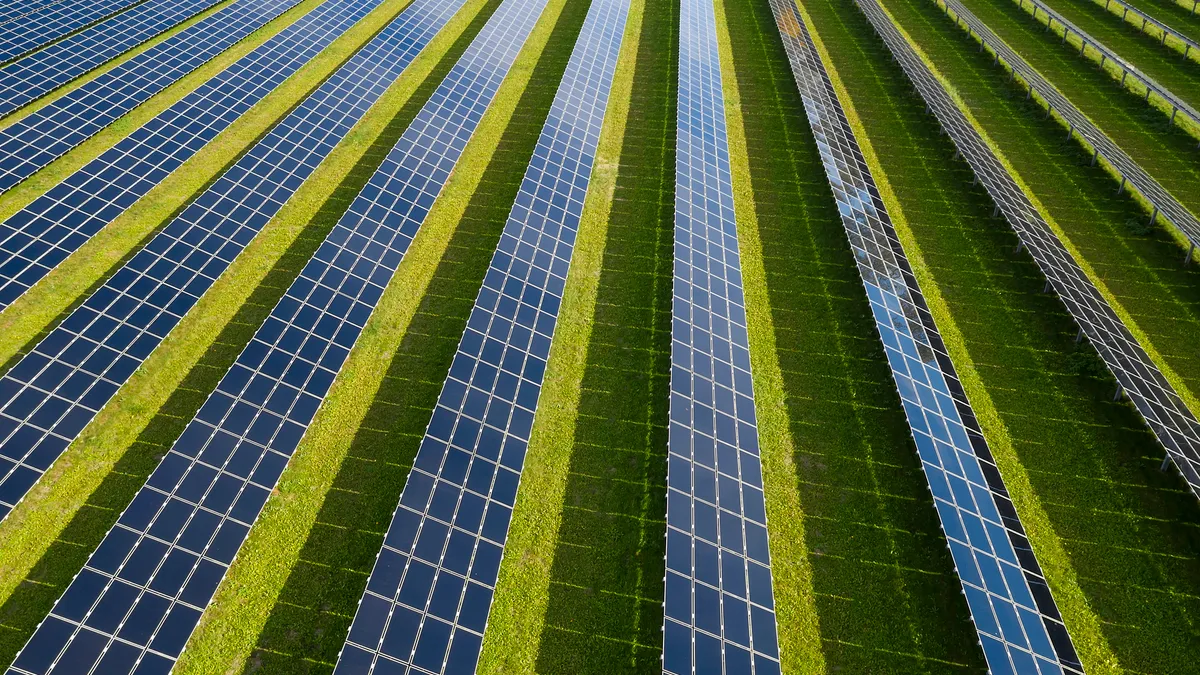Dive Brief:
- Building out U.S. solar manufacturing domestically is proving challenging due to factors like high interest rates, labor shortages and steep competition, according to both industry and government representatives speaking Tuesday on a 2024 RE+ panel.
- “It's going to be really tough for the U.S. supply chain …. to compete against other countries that are acting in ways that are not economic, or that are hiding subsidies or have lower worker standards or lower environmental standards,” said Arthur Haubenstock, chief strategy advisor in the U.S. Department of Energy’s Office of Manufacturing and Energy Supply Chains.
- But panelists Jessica Lawrence-Vaca, a senior vice president at Array Technologies, and Kelly Speakes-Backman, an executive vice president at Invenergy, voiced concerns about the second-order effects of government interventions like tariffs.
Dive Insight:
“We're looking at what impacts module manufacturers, and any tariffs that have been applied impact the whole rest of the manufacturing supply chain,” Lawrence-Vaca said. “So I think being really mindful and thoughtful about how we apply policies going forward – but I think that the US government is getting a lot better about talking to all the different organizations, because I think previously the left hand was not talking the right hand.”
Lawrence-Vaca also noted that she advocates for recognition that solar manufacturers are not always aligned on what policies the U.S. government should adopt due to being impacted differently, and that industry and government should work closely to ensure the latter is “pulling the right levers.”
Speakes-Backman suggested the government could do more to recognize that within the U.S. solar industry, “there are a set of incumbents that may want to hold more of their market share rather than grow the pie.”
“Because a little bit of this is also just sort of good old fashioned competition and trying to get your message out there in order to tamp down competition,” she said.
Tracking system manufacturer Array Technologies in April voiced opposition to a petition filed that month with the U.S. International Trade Commission and Department of Commerce by an alliance of seven U.S. solar manufacturers, asking for antidumping and countervailing duties to be imposed on crystalline silicon solar cells imported from Cambodia, Malaysia, Thailand and Vietnam. CEO Kevin Hostetler said, “The threat of duties alone can cause major disruption to the solar industry and hurt manufacturers like Array that rely on a thriving market to do business.”
Panelist Cora Dickson, a renewable energy lead at the Department of Commerce’s International Trade Administration, noted that there have recently been “record imports” of solar panels into the U.S. – saying a back-of-the-napkin estimate of imported versus manufactured panels showed significant import dominance.
“There's this flood of imports, and I just want to make sure everybody's aware of that, and all of the talk of tariffs – actually, we don't have a problem with importing,” Dickson said. “We have a problem with protecting domestic manufacturers from unfair prices.”
Dickson said that if the U.S. “can’t compete with imports on price, or there’s simply oversupply, then [U.S.] module manufacturing is slow to get off the ground, and that backs up everything else.”
Federal insights
Haubenstock said he thinks it’s not only trade tariffs that expose U.S. module manufacturers to risk, but the fact that “we're so reliant on relatively small number of sources for the materials that module manufacturers need to operate, and the forces that are behind those sources have acted in uneconomic ways.”
China, which has established dominance as both a critical minerals supplier and the world’s largest producer of solar panels and cells, was targeted earlier this year with increased solar Section 301 tariffs and named in the April petition as trying to continue to oversupply the U.S. market by routing solar exports through other countries to circumvent the tariffs.
Haubenstock said the U.S. government “may have to take some actions” to protect the jobs and economic growth provided by the booming solar industry. “I would love to see the demand just work,” he said, but the Department of Energy’s analyses – both public and internal – indicate a difficult road ahead for the U.S. as it competes with “uneconomic” actors. And it’s new for the U.S., he said, to think about this issue in a whole of government, interagency way. The Department of Energy Sept. 12 announced $40 million of investments to help support a domestic solar supply chain.
“I've been at Commerce since 2001, and it wasn't until five years ago that we really started looking at it this way,” Dickson said. “We need to develop data-driven analysis, predictive models, all those things. We're really in a whole new world right now. But it's not just government alone, we're listening to what industry has to say. Coming to RE+ is always an eye-opener.”
Haubenstock said that labor shortages across the clean energy industry is one supply chain issue that DOE has “heard a lot about recently in meetings with leading CEOs across the clean energy space.”
“I was actually kind of surprised that for most of them, either the first thing they mentioned but definitely about the third thing they mentioned, was a skilled workforce,” he said. “A skilled workforce is definitely slowing the train. I think there's a huge amount of work to do to get more skilled workers into the industry, and we want to partner with industry to do that.”














